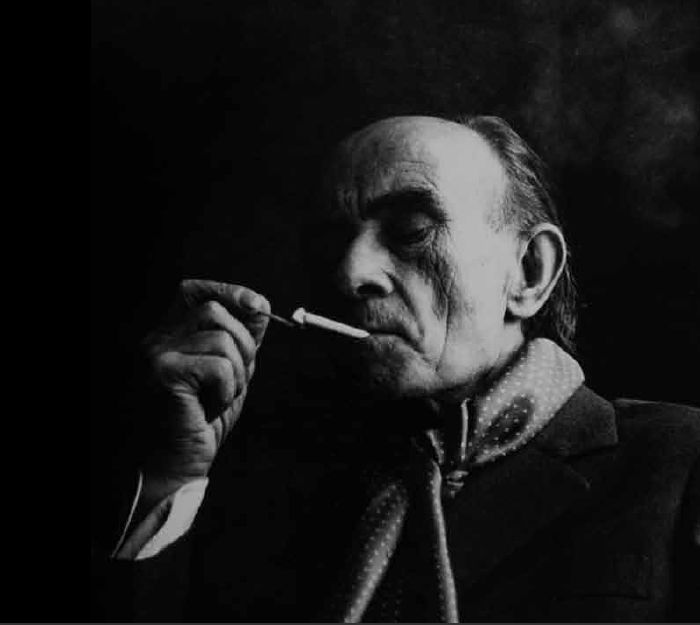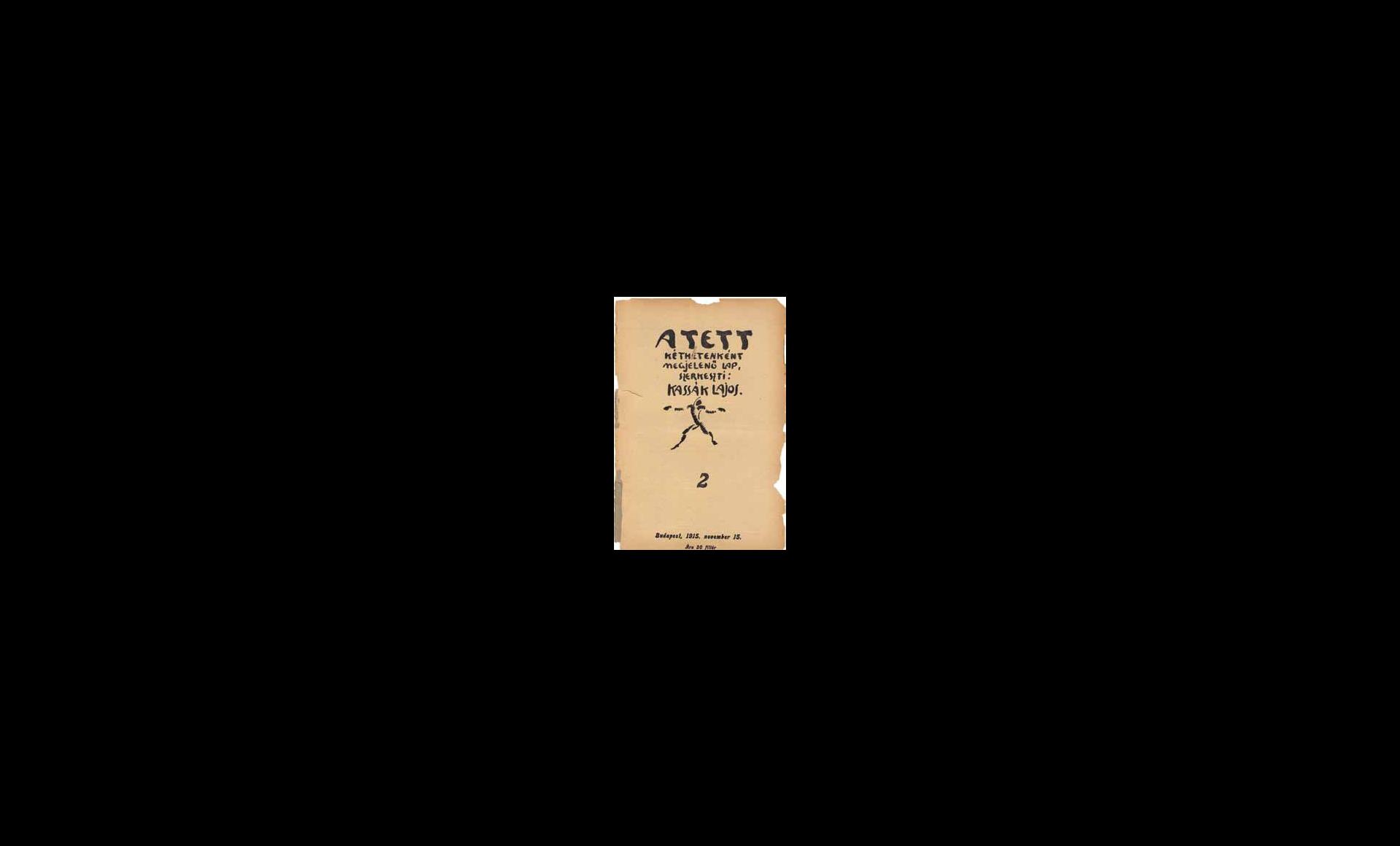
Introduction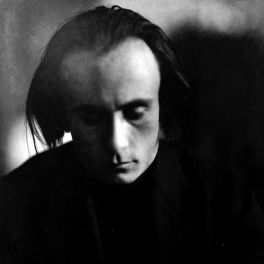 The Kassák Museum’s permanent exhibition presents the literary, artistic and journalistic oeuvre of Lajos Kassak (1887-1967), the leading figure of the Hungarian avant garde. Independent in thought and action, he first appeared in the 1910s as an artist of a type that was utterly new in Hungary, and his responses to historical and social challenges through the successive stages of his life were unceasingly original. Born into a half-Magyar, half-Slovak family, with no scholarly background, he developed his own way of thinking, innovative and wide-ranging, and from his own strengths alone grew into an
The Kassák Museum’s permanent exhibition presents the literary, artistic and journalistic oeuvre of Lajos Kassak (1887-1967), the leading figure of the Hungarian avant garde. Independent in thought and action, he first appeared in the 1910s as an artist of a type that was utterly new in Hungary, and his responses to historical and social challenges through the successive stages of his life were unceasingly original. Born into a half-Magyar, half-Slovak family, with no scholarly background, he developed his own way of thinking, innovative and wide-ranging, and from his own strengths alone grew into an
international authority. He never ossified into the pose of artistic giant, and his strong individuality kept him open and dynamic, able to collaborate, and think collectively. Communities grew up around him – the people who worked with him in editing journals, a cultural society, and a walking group where young working-class people shared experiences and visions of the future. Kassák was a pioneer of the modern attitude that artistic activity is not constrained by the boundaries of aesthetics: he created art which linked social criticism with bold ideas for the future.
Kassák’s periodicals in the 1910s and 1920s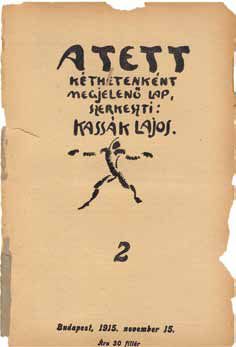 A Tett, 1915 – 1916 Kassák started up his first journal, A Tett (“The Action”), during the First World War. A Tett had a tone and a European perspective which the public of the time found provocative. Its models and precursors were German journals with social and political inclinations, and Dadaist-influenced publications. Although the journal became the target of numerous political attacks for its anti-war rhetoric and anarchist views, its propagation of radical ideas on the purpose of art succeeded in encouraging the embryonic artistic avant garde and the activist movement. It was in A Tett that Guillaume Apollinaire and Marinetti were first published in Hungary. A Tett survived for a total of 17 issues between 1 November 1915 and October 1916. Kassák devoted the last, international issue to works and writing by artists from countries at war with the Monarchy. The prosecutor’s office responded by finally closing it down. A Tett’s other editors included Dezső Szabó, Aladár Komjáth, Mátyás György, József Lengyel, Andor Halasi, János Mácza, Vilmos Rozványi, Imre Vajda and Béla Uitz.
A Tett, 1915 – 1916 Kassák started up his first journal, A Tett (“The Action”), during the First World War. A Tett had a tone and a European perspective which the public of the time found provocative. Its models and precursors were German journals with social and political inclinations, and Dadaist-influenced publications. Although the journal became the target of numerous political attacks for its anti-war rhetoric and anarchist views, its propagation of radical ideas on the purpose of art succeeded in encouraging the embryonic artistic avant garde and the activist movement. It was in A Tett that Guillaume Apollinaire and Marinetti were first published in Hungary. A Tett survived for a total of 17 issues between 1 November 1915 and October 1916. Kassák devoted the last, international issue to works and writing by artists from countries at war with the Monarchy. The prosecutor’s office responded by finally closing it down. A Tett’s other editors included Dezső Szabó, Aladár Komjáth, Mátyás György, József Lengyel, Andor Halasi, János Mácza, Vilmos Rozványi, Imre Vajda and Béla Uitz.
MA, Budapest 1916 – 1919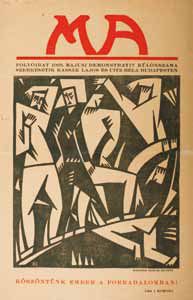 After A Tett was banned, Kassák launched a new journal, MA (“Today”). MA came out in Budapest 35 times from 15 November 1916 to 1 July 1919, edited by Kassák, Béla Uitz, Sándor Bortnyik, Jolán Simon, Sándor Barta and Erzsi Ujvári. The journal’s subtitle changed several times – originally Journal of Literature and the Arts, then Activist Journal, and finally Activist Journal of Arts and Social Affairs – indicating its intended role in the historical developments of the late 1910s. During the Republic of Councils, Kassák stood up for the autonomy of art and became embroiled in an ideological dispute with Béla Kun. The journal was banned. The fall of the Republic of Councils brought even worse times for Kassák: after a period of imprisonment he – together with many other intellectuals – left the country in 1920 and took up a life of exile in Vienna. During these years in Budapest, Kassák and the MA Circle engaged in organisational activities which went far beyond editing a journal. Through their books, exhibitions and cultural events, they assumed the task of propagating ideas that spanned art, literature and music.
After A Tett was banned, Kassák launched a new journal, MA (“Today”). MA came out in Budapest 35 times from 15 November 1916 to 1 July 1919, edited by Kassák, Béla Uitz, Sándor Bortnyik, Jolán Simon, Sándor Barta and Erzsi Ujvári. The journal’s subtitle changed several times – originally Journal of Literature and the Arts, then Activist Journal, and finally Activist Journal of Arts and Social Affairs – indicating its intended role in the historical developments of the late 1910s. During the Republic of Councils, Kassák stood up for the autonomy of art and became embroiled in an ideological dispute with Béla Kun. The journal was banned. The fall of the Republic of Councils brought even worse times for Kassák: after a period of imprisonment he – together with many other intellectuals – left the country in 1920 and took up a life of exile in Vienna. During these years in Budapest, Kassák and the MA Circle engaged in organisational activities which went far beyond editing a journal. Through their books, exhibitions and cultural events, they assumed the task of propagating ideas that spanned art, literature and music.
MA, Vienna 1920 – 1926 In 1920, MA was relaunched in the very different cultural milieu of Vienna. Exile caused the journal to take on a new perspective. Kassák quickly entered the international network of avant garde journals, and within a few years became a respected figure of European modernism. He became acquainted with Kurt Schwitters, Tristan Tzara, El Lissitzky and Hans Arp. Several of the friendships he forged with artists at that time persisted to the end of his life. It was in this milieu that Kassák became an artist and a committed disciple of Constructivism. In 1924, he exhibited in the Sturm Gallery in Berlin. His theoretical work also developed during his years in Vienna. He wrote the theory of Image Architecture, and was an active participant in the international discourse of contemporary art.
In 1920, MA was relaunched in the very different cultural milieu of Vienna. Exile caused the journal to take on a new perspective. Kassák quickly entered the international network of avant garde journals, and within a few years became a respected figure of European modernism. He became acquainted with Kurt Schwitters, Tristan Tzara, El Lissitzky and Hans Arp. Several of the friendships he forged with artists at that time persisted to the end of his life. It was in this milieu that Kassák became an artist and a committed disciple of Constructivism. In 1924, he exhibited in the Sturm Gallery in Berlin. His theoretical work also developed during his years in Vienna. He wrote the theory of Image Architecture, and was an active participant in the international discourse of contemporary art.
MA ultimately survived for 10 years, making it the longest-lasting journal with such a modern outlook in the period.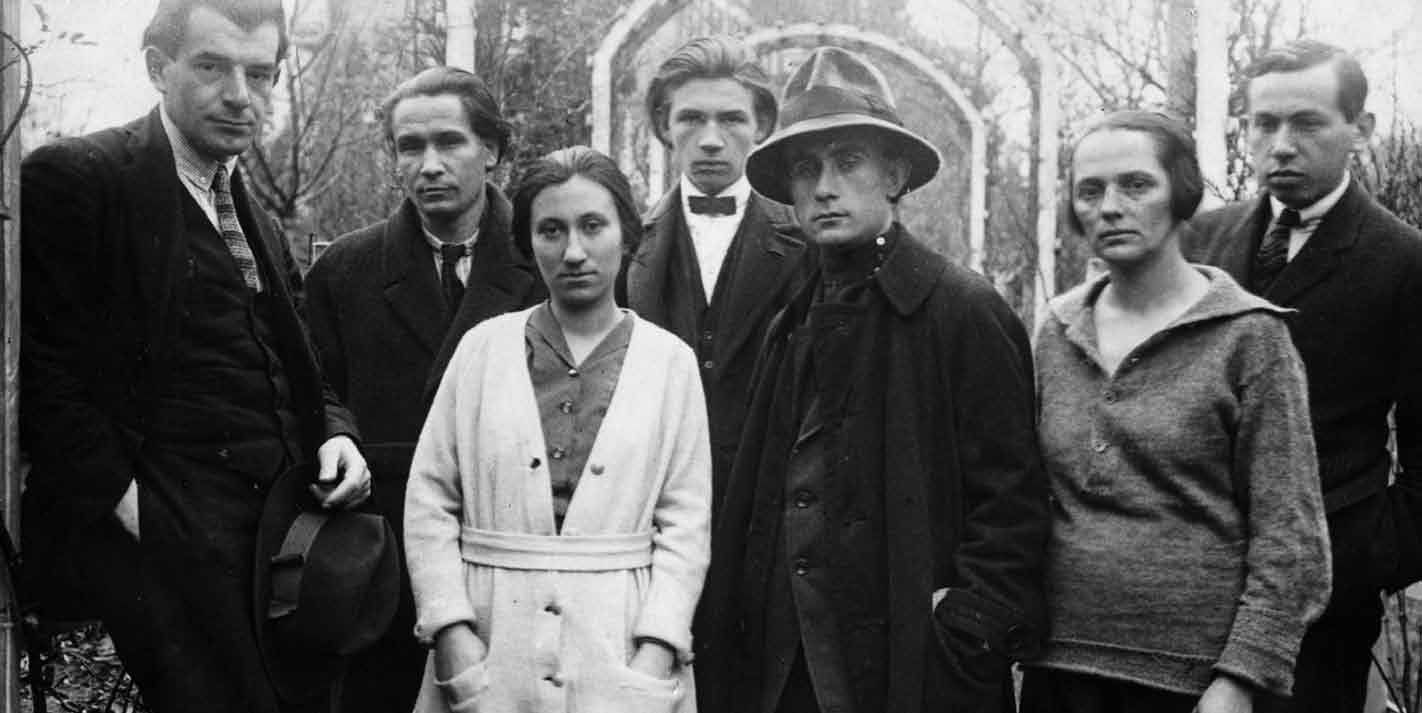
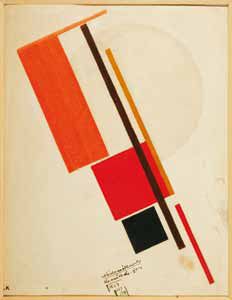
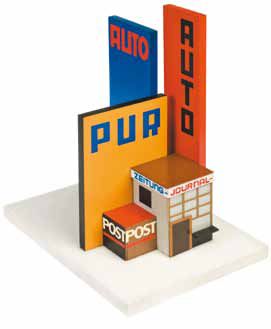
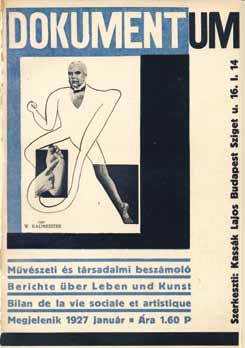 In the second half of the nineteen twenties, together with European modernism in general, Kassák and MA found themselves increasingly in a vacuum. Kassák returned home in autumn 1926, and in December of that year launched a new journal, Dokumentum. His main colleagues in this project were Tibor Déry, Gyula Illyés, József Nádass and Andor Németh. As with MA, Kassák placed Dokumentum in the international perspective, as evidenced by its appearing in three languages: Hungarian, German and French. Kassák wanted to make up for the deficit of information on contemporary European art by publishing foreign writers. He extended his interest to modern architecture, music and dance, and particularly to film. Kassák was the first to present contemporary Russian art in Hungary. The journal’s compass went well beyond the accepted boundaries of art of the time. It gave space to new lines of enquiry like the multifaceted study of society and social issues in art. The public of the time, however, was not receptive to this new approach, and Dokumentum petered out after a year.
In the second half of the nineteen twenties, together with European modernism in general, Kassák and MA found themselves increasingly in a vacuum. Kassák returned home in autumn 1926, and in December of that year launched a new journal, Dokumentum. His main colleagues in this project were Tibor Déry, Gyula Illyés, József Nádass and Andor Németh. As with MA, Kassák placed Dokumentum in the international perspective, as evidenced by its appearing in three languages: Hungarian, German and French. Kassák wanted to make up for the deficit of information on contemporary European art by publishing foreign writers. He extended his interest to modern architecture, music and dance, and particularly to film. Kassák was the first to present contemporary Russian art in Hungary. The journal’s compass went well beyond the accepted boundaries of art of the time. It gave space to new lines of enquiry like the multifaceted study of society and social issues in art. The public of the time, however, was not receptive to this new approach, and Dokumentum petered out after a year.
The Munka Ci rcle (1928 – 1934)
Driven by his vision of the workers as a force for transforming society, Kassák took up the cause of workers’ education in the late 1920s. Setting himself the goal of educating young people in
class-consciousness and solidarity, he founded the journal Munka [Work] in 1928 and brought together students and young workers into what became known as the Munka Circle. Kassák gradually built up the Kulturstudió (“Cultural Studio”), approaching worker education as a whole way of life, through a unity of organised activities, entertainment, recreation and education. His ambitious aims drew contributions from several fine teachers and artists. Jolán Simon organised a speaking choir, Sándor Jemnitz a modern- music chamber chorus, and György Justus a folk-song choir based on Bartók-Kodály principles. The painting group of the Circle was led by students of the Academy of Fine Arts – Béla Hegedüs, György Kepes, Dezső Korniss, Ernő Schubert, Sándor Trauner and Lajos Vajda – whom Kassák had met at a joint Schubert-Trauner exhibition in the Mentor Bookshop. The Munka Circle was a culturally and politically open group, and its members constantly brought with them more and more new people, friends and colleagues.
The spirit of the Munka journal, and the subjects of its articles, focused on the social reality of the time rather than the issues of art itself. Most of the essays published in Munka were based on
the world of fact, and social analysis, technical progress, collective action and physical culture were constant themes. The format of the journal and its low price also served to bring this information to as wide a readership as possible.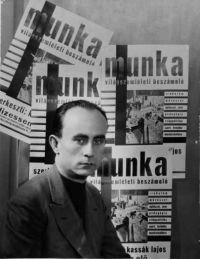 The Circle was eventually brought to an end by an Interior Ministry decree of 1934. The Kulturstudió and other national speaking choirs and cultural groups were banned, but the disintegration of the Munka Circle was accelerated by internal tensions. Munka was able to carry on publishing for another five years, until 1939, maintaining throughout the highest standards of any left-wing journal. Its articles criticised fascism and Stalinism, and attempted to propagatethe message that without culture, the masses were vulnerable to manipulation by extreme political forces.
The Circle was eventually brought to an end by an Interior Ministry decree of 1934. The Kulturstudió and other national speaking choirs and cultural groups were banned, but the disintegration of the Munka Circle was accelerated by internal tensions. Munka was able to carry on publishing for another five years, until 1939, maintaining throughout the highest standards of any left-wing journal. Its articles criticised fascism and Stalinism, and attempted to propagatethe message that without culture, the masses were vulnerable to manipulation by extreme political forces.
In the 1930s, Kassák started to take an interest in photography as a documentary medium, although he did not take photographs himself. The intellectual milieu of Munka nurtured the Hungarian sociophotographic movement, which was active between 1930 and 1932. During this period, it held the first Hungarian sociophotographic exhibition and published the first Hungarian sociophotographic book, A mi életünkből (From Our Lives). This marked the end-point of two years of collective studio work which had resulted in several publications at home and abroad, three exhibitions in Budapest, and two abroad.
Photomontage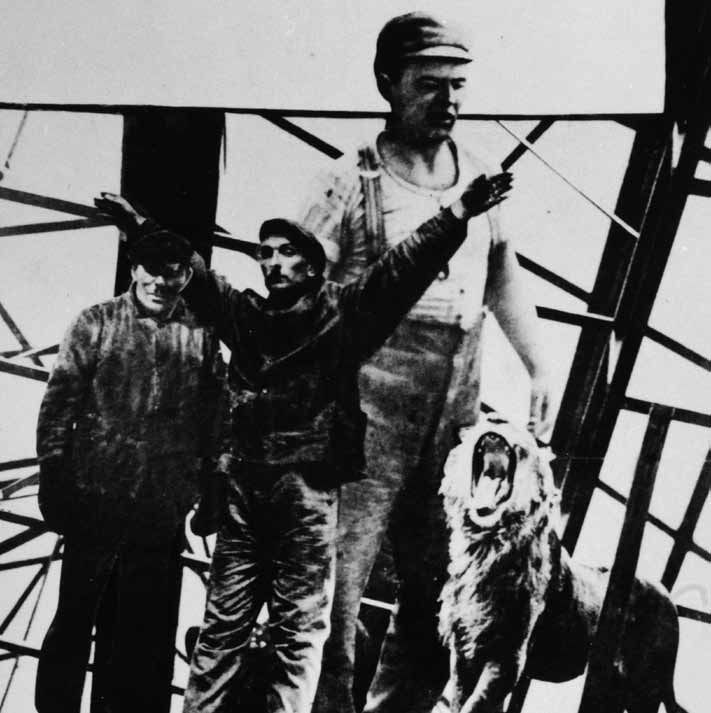 The exhibition’s section on the Munka Circle includes Kassák’s photomontages, aimed at conveying how social movements (and not just the workers’ movement) related to visuality. The demands of accessibility and visibility and the use of the most advanced means of communication were basic criteria for Kassák’s workingclass culture-building manifesto. The montage, powerfully persuasive and easily interpreted, served as a visual channel for these efforts. Its visual language proved more effective and communicative than any pamphlet, appeal or manifesto.
The exhibition’s section on the Munka Circle includes Kassák’s photomontages, aimed at conveying how social movements (and not just the workers’ movement) related to visuality. The demands of accessibility and visibility and the use of the most advanced means of communication were basic criteria for Kassák’s workingclass culture-building manifesto. The montage, powerfully persuasive and easily interpreted, served as a visual channel for these efforts. Its visual language proved more effective and communicative than any pamphlet, appeal or manifesto.
After the Second World War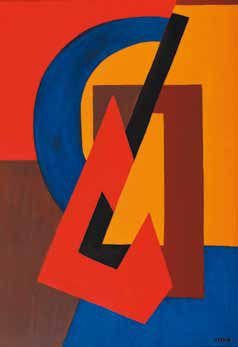 In the brief democratic interlude following the Second World War, Kassák became actively involved in public affairs as vicechairman of the Arts Council, a consultant body to the Ministry of Religion and Education, editing its journal Alkotás (1947–48). This represented progressive views, domestic and European, in the broadest sense. In the same years he also edited Kortárs, a literary and social affairs journal attached to the Social Democratic Party. In 1947, Kassák became a member of Parliament for that party. Both journals were closed after the Communist takeover, and Kassák was excluded from both public and intellectual affairs. This effectively marked the end of the prominent role he had played as a shaper of social and artistic life for several decades. His house in Békásmegyer became a place of exile and solitude. His official treatment changed only after 1956, when he became accepted as a writer, but still had no outlet as an artist. The works of his later artistic period and the phases of literary canonisation appear in this exhibition only as markers, but the digital exhibits present these in more depth.
In the brief democratic interlude following the Second World War, Kassák became actively involved in public affairs as vicechairman of the Arts Council, a consultant body to the Ministry of Religion and Education, editing its journal Alkotás (1947–48). This represented progressive views, domestic and European, in the broadest sense. In the same years he also edited Kortárs, a literary and social affairs journal attached to the Social Democratic Party. In 1947, Kassák became a member of Parliament for that party. Both journals were closed after the Communist takeover, and Kassák was excluded from both public and intellectual affairs. This effectively marked the end of the prominent role he had played as a shaper of social and artistic life for several decades. His house in Békásmegyer became a place of exile and solitude. His official treatment changed only after 1956, when he became accepted as a writer, but still had no outlet as an artist. The works of his later artistic period and the phases of literary canonisation appear in this exhibition only as markers, but the digital exhibits present these in more depth.
Literary work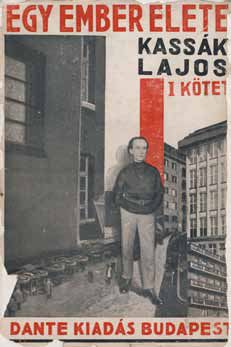 The visual presentation of Kassák’s literary work forms As part of its all-embracing approach to Kassák’s wide-ranging activity, the exhibition includes a visual presentation of his literary work, journalism and criticism. The chronology of work published during his life gives a good picture of both his activities as a writer and his periods of silence. The regular republication of some of his books indicates the growing appreciation of his writing, and the titles also reveal the subjects and approaches that preoccupied him at various stages of his career. Since Kassák designed many of his own book covers, these also give an impression of his changing artistic outlook.
The visual presentation of Kassák’s literary work forms As part of its all-embracing approach to Kassák’s wide-ranging activity, the exhibition includes a visual presentation of his literary work, journalism and criticism. The chronology of work published during his life gives a good picture of both his activities as a writer and his periods of silence. The regular republication of some of his books indicates the growing appreciation of his writing, and the titles also reveal the subjects and approaches that preoccupied him at various stages of his career. Since Kassák designed many of his own book covers, these also give an impression of his changing artistic outlook.
Kassák’s reception as an artist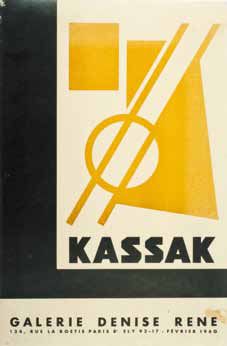 Although the Kádár-era cultural authorities recognised Kassák as a writer and rewarded him with the highest state honours, they never accepted his artistic output during his lifetime. His life’s work went on display in Hungary only once, a few months before his death, at his own expense, and in the humble surroundings of the Adolf Fényes Room in Budapest.
Although the Kádár-era cultural authorities recognised Kassák as a writer and rewarded him with the highest state honours, they never accepted his artistic output during his lifetime. His life’s work went on display in Hungary only once, a few months before his death, at his own expense, and in the humble surroundings of the Adolf Fényes Room in Budapest.
By contrast, international developments brought him renewed recognition in his old age. In the 1960s, Western art historians and art dealers alike rediscovered the Eastern European avant garde. This resurgence of interest launched Kassák back into the European artistic current. In his final years, his works appeared in several individual and collective exhibitions, mainly in Western Europe.